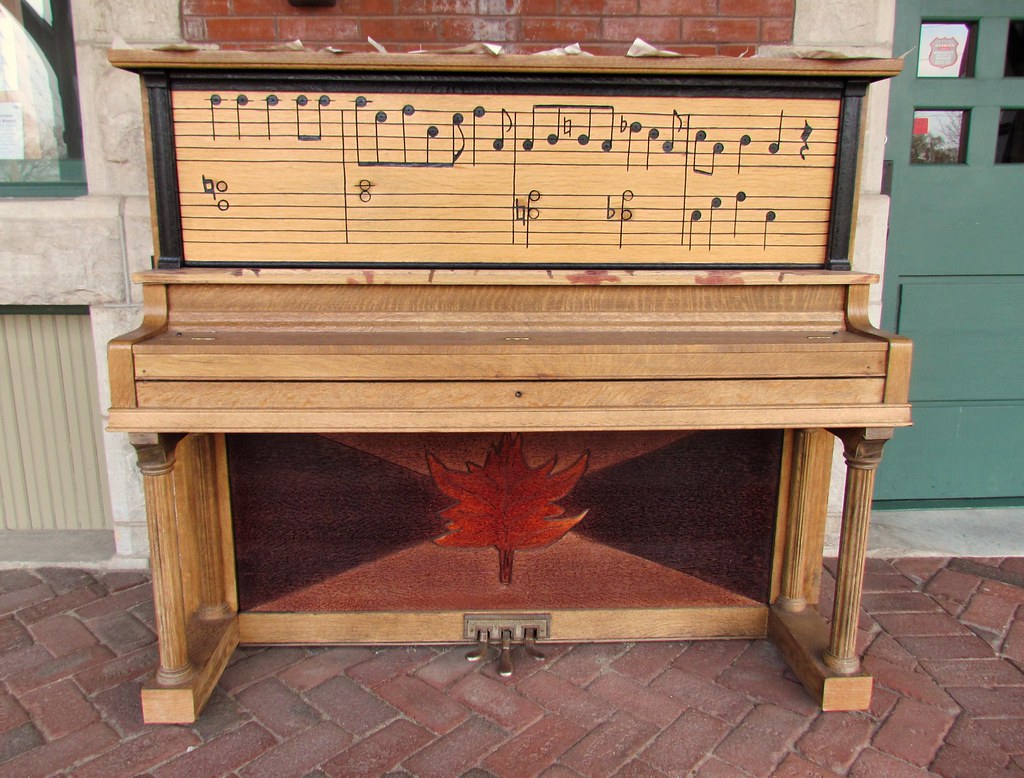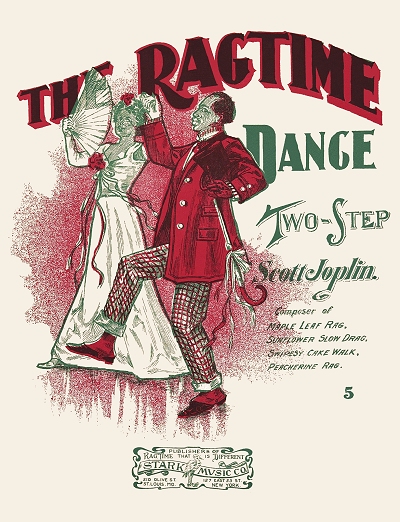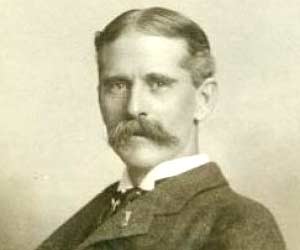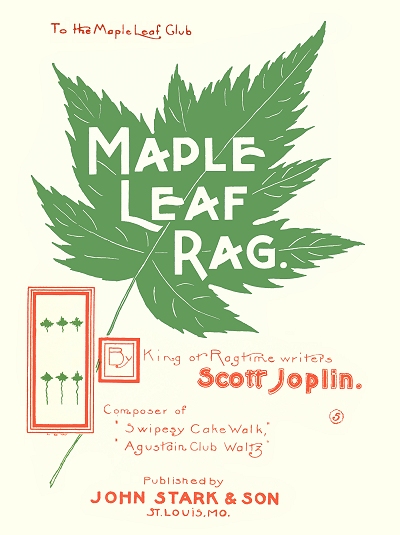"Use the talents you possess, for the woods would
be very silent if no birds sang except the best."
AUTHOR: Henry Van Dyke
MEANING OF THE QUOTE:
"A person does not have to be a professional musician
in order to experience the joys of making music."
COMPOSER
MAPLE LEAF RAG
Written in 1899, although not the first rag
written or published as Ragtime had been
around for only a few years,
the Maple Leaf Rag
MAPLE LEAF RAG
Orchestra Version
 |
| The dancers depicted on the cover are none other than famous black vaudeville stars George Walker and Bert Williams and their wives dancing the cakewalk. |
Arthur Fiedler, Conductor
Boston Pops
Boston Pops
(also a favorite of President Theodore
Roosevelt's daughter) became the first
instrumental piece to sell over one
million copies. (The Charles K. Harris
 |
| http://parlorsongs.com/bios /ckharris/ckharris.php |
song, "After The Ball"
AFTER THE BALL

Sung by Charles K. Harris
Published in 1892, it was supposedly
the first song to sell a million copies
of sheet music. This film must have
been made prior to December 1930
when Harris died.
from 1888, was the first million selling
piece of sheet music, but Maple Leaf
did it in a shorter amount of time,
reportedly in less than a decade.)

In the days before mainstream
sound recording it was this best
selling sheet music of Scott Joplin's
which helped propel the popularity of
the Ragtime style to move from the
bars, where it originated,
 |
| Bar Room Performances |
into respectable homes
and public places.
| Parlor Music |
The rag was named in honor of the venue,
the Maple Leaf Club

in which it was allegedly first heard (and
one of the clubs where Joplin performed)
by the white Sedalia businessman and
Joplin music publisher, John Stark.
 |
| John Stark |
The probable source of the name
followed the trend of naming
organizations after trees in the area.

Before working for Stark
 |
| Stark |
Joplin encountered many rejections
and was unable to make any substantial
sales but after the piece was an instant
success and its first printing of 10,000
copies sold out quickly (75,000 copies
were sold within six months). More than
half a million copies were sold by 1909.
(All these sold without the promotional
help of radio, television, or the internet
which did not exist yet.) Stark and Joplin
signed a contract and both moved to
St. Louis, Missouri.
St. Louis, Missouri.

There Stark vigorously promoted his
client giving him the nickname
"King of Ragtime."
The financial success of the
Maple Leaf Rag not only created a
demand for more Joplin compositions
but also enabled Stark to open a music
store and printing shop in St. Louis
and then later in New York.

There are many stories about how Joplin
and Stark became associated as a result
of this rag. Research done by a Joplin
biographer, Edward Berlin,
said that a young lawyer, a friend of
Stark's son, who was running the
Sedalia store, offered to help Joplin
present the piece to the firm as well as
draw up the paperwork. When Stark
heard the piece he was impressed
enough not only to take on the Maple
Leaf Rag but to offer Joplin an unheard
of royalty agreement as well (a one-cent
royalty for each copy and ten free copies
for his own use including an advance; an
estimated $360 per year on this piece
in his lifetime).
 |
| http://forum.skyscraperpage.com/showthread.php?t=195574 |
MAPLE LEAF RAG
Played by Jelly Roll Morton
| Jelly Roll Morton |
An advertisement for Scott Joplin's "Maple Leaf Rag" from the back
page of a rag by Joseph Lamb. Both published with John Stark's firm.
 |
"Missouri in 1898: Scott Joplin and the 'Maple Leaf Rag.'" v. 92, no. 4 (July 1998), inside back cover. http://shs.umsystem.edu/historicmissourians/name/j/joplin/ |
MAPLE LEAF RAG
Instrumental Big Band
Swing Version
MAPLE LEAF RAG
LESSON PLAN
FROM
CLASSICS FOR KIDS
MAPLE LEAF RAG
 |
MAPLE LEAF RAG SONG
By 1903 the Maple Leaf Rag was quickly becoming
a standard among both professional and amateur
pianists, and sales were increasing outside of John
Stark's realm in St. Louis as well. Even though the
composer was currently in one of his feuds with
Stark and not submitting new pieces to him, the
publisher owned the rights to the rag and felt it was
appropriate for him to also put it out as a song.
pianists, and sales were increasing outside of John
Stark's realm in St. Louis as well. Even though the
composer was currently in one of his feuds with
Stark and not submitting new pieces to him, the
publisher owned the rights to the rag and felt it was
appropriate for him to also put it out as a song.



The lyrics that Sydney Brown applied to it were some
what racist in tone, and in spite of Joplin's reference
to razor blades in the opening verse
of his 1902 Ragtime Dance,
what racist in tone, and in spite of Joplin's reference
to razor blades in the opening verse
of his 1902 Ragtime Dance,

it is unlikely that he would have been
appreciative of the tone of this contrived
song. They apply only to the A section of
the piece, and tell the story of a mildly
arrogant Negro who was rescued from a
pending fight at a ragtime ball by the ladies
who surrounded him. The arrogance
is evident in the tag line,
appreciative of the tone of this contrived
song. They apply only to the A section of
the piece, and tell the story of a mildly
arrogant Negro who was rescued from a
pending fight at a ragtime ball by the ladies
who surrounded him. The arrogance
is evident in the tag line,
"Oh go 'way man I can hypnotize dis nation, I can
shake de earth's foundation wid de Maple Leaf Rag."



The very nature of the syllabic complexity of the lyrics
force a somewhat subdued performance speed.
The B and D sections (the trio was excised) are used
merely for a dance, and don't translate with the same
vibrancy in the new key of Eb, a fourth lower than the
original Ab. Joplin was unlikely to have arranged this
version. It was perhaps due to a number of these
factors that the song was buried in mediocrity with any
number of race-related songs of the time, even though
the rag continued to create strong revenue for Stark.
shake de earth's foundation wid de Maple Leaf Rag."



The very nature of the syllabic complexity of the lyrics
force a somewhat subdued performance speed.
The B and D sections (the trio was excised) are used
merely for a dance, and don't translate with the same
vibrancy in the new key of Eb, a fourth lower than the
original Ab. Joplin was unlikely to have arranged this
version. It was perhaps due to a number of these
factors that the song was buried in mediocrity with any
number of race-related songs of the time, even though
the rag continued to create strong revenue for Stark.



MAPLE LEAF RAG SONG
With Written Lyrics
(Written in the African-American Vernacular English
of the time, with no intention to offend anybody)
Sydney Brown, Lyrics
Scott Joplin, Music



MAPLE LEAF RAG SONG
FROM THE
LIBRARY OF CONGRESS





Brown's lyrics tell the story of a poor man
from Accomack County, Va., who stumbles
into a ballroom where, in spite of his anxiety
over the state of his appearance, he manages
to wow the crowd with the Maple Leaf Rag.
While the men are jealous of his dancing
abilities and draw their razors, the women
love him, and the "finest belle" sends for a
carriage and the two of them ride away.



MAPLE LEAF RAG SONG
(Written in the African-American Vernacular English
of the time, with no intention to offend anybody)
VERSE 1:
I came from ole Virginy From de county Acomac
I have no wealth to speak of 'cept de clothes upon my back.
I can do de country hoe down I can buck and wing to show down,
And while I'm in the notion just step back and watch my motion.
CHORUS:
Oh go 'way man I can hypnotize dis nation,
I can shake de earth's foundation wid de Maple Leaf Rag
Oh go 'way man just hold you breath a minit,
For there's not a stunt thats in it with the Maple Leaf Rag.

VERSE 2:
I dropp'd into de swellest ball, The great exclusive it,
But my face was dead agin me and my trousers didn't fit.
But when Maple Leaf was started my timidity departed.
I lost my trepidation you could taste de admiration.
CHORUS:
Oh go 'way man I can hypnotize dis nation,
I can shake de earth's foundation wid de Maple Leaf Rag
Oh go 'way man just hold you breath a minit,
For there's not a stunt thats in it with the Maple Leaf Rag.

INTERLUDE WITH DANCE

VERSE 3:
De men were struck wid jealousy, De razors 'gan to flash.
But de ladies gathered 'round me for I'd sholy made a mash.
De finest belle she sent a boy to call a coach and four.
We rode around a season till we both were lost to reason.
CHORUS:
Oh go 'way man I can hypnotize dis nation,
I can shake de earth's foundation wid de Maple Leaf Rag
Oh go 'way man just hold you breath a minit,
For there's not a stunt thats in it with the Maple Leaf Rag.

Note: The song is in Eb, not Ab like the rag,
and the C section is omitted.
http://www.perfessorbill.com/lyrics/lymaple.htm



MAPLE LEAF RAG SONG
With Sung Lyrics
(Written in the African-American Vernacular English
of the time, with no intention to offend anybody)
Sydney Brown, Lyrics
Scott Joplin, Music
Alide M.Salvetta-Antonio Ballista, Vocalist




LINKS
http://www.classicsforkids.com/activitysheets/June2010.pdf
http://www.123helpme.com/view.asp?id=85127
http://www.songfacts.com/detail.php?id=13716
http://highered.mheducation.com/sites/0073526576/
student_view0/chapter4/listening_guides.html#a
http://reharmonized.an-earful.com/introjazz/listening_guides_early.html
http://www.vh1.com/partners/vh1_music_studio/supplies
/specials/pop_icons_p6-lesson2.html
http://www.123helpme.com/view.asp?id=85127
http://www.songfacts.com/detail.php?id=13716
http://highered.mheducation.com/sites/0073526576/
student_view0/chapter4/listening_guides.html#a
http://reharmonized.an-earful.com/introjazz/listening_guides_early.html
http://www.vh1.com/partners/vh1_music_studio/supplies
/specials/pop_icons_p6-lesson2.html
Played on a Seeburg Style H



This is a machine that plays music and is
designed to sound like an orchestra or
band. The sound is usually produced by
pipes as well as percussion instruments.
with many orchestrions containing a piano
as well.The first known automatic playing
orchestrion was the panharmonicon,

who was also known as the
inventor of the metronome.
 |
| Pyramidal Metronome |







.JPG)






